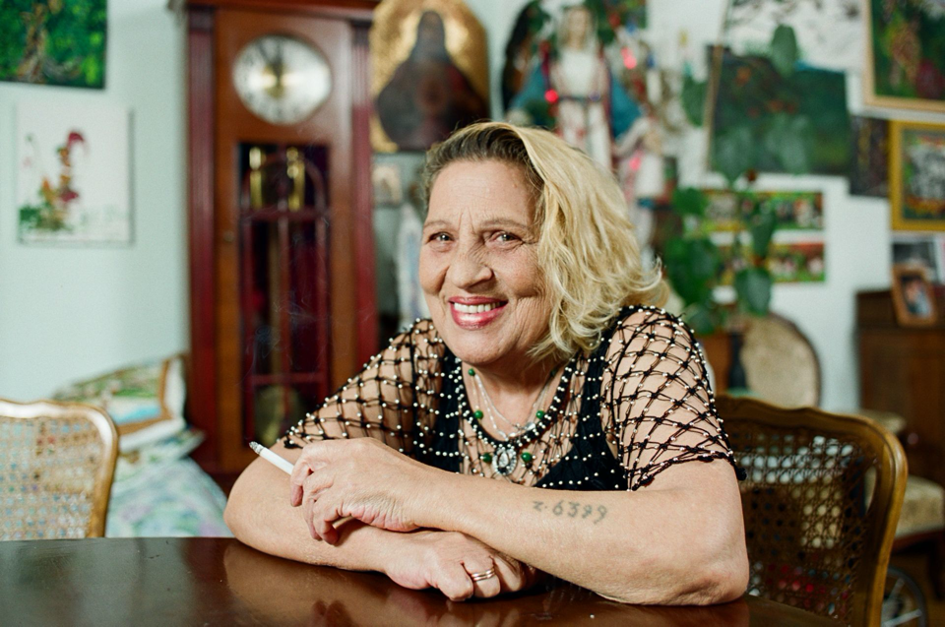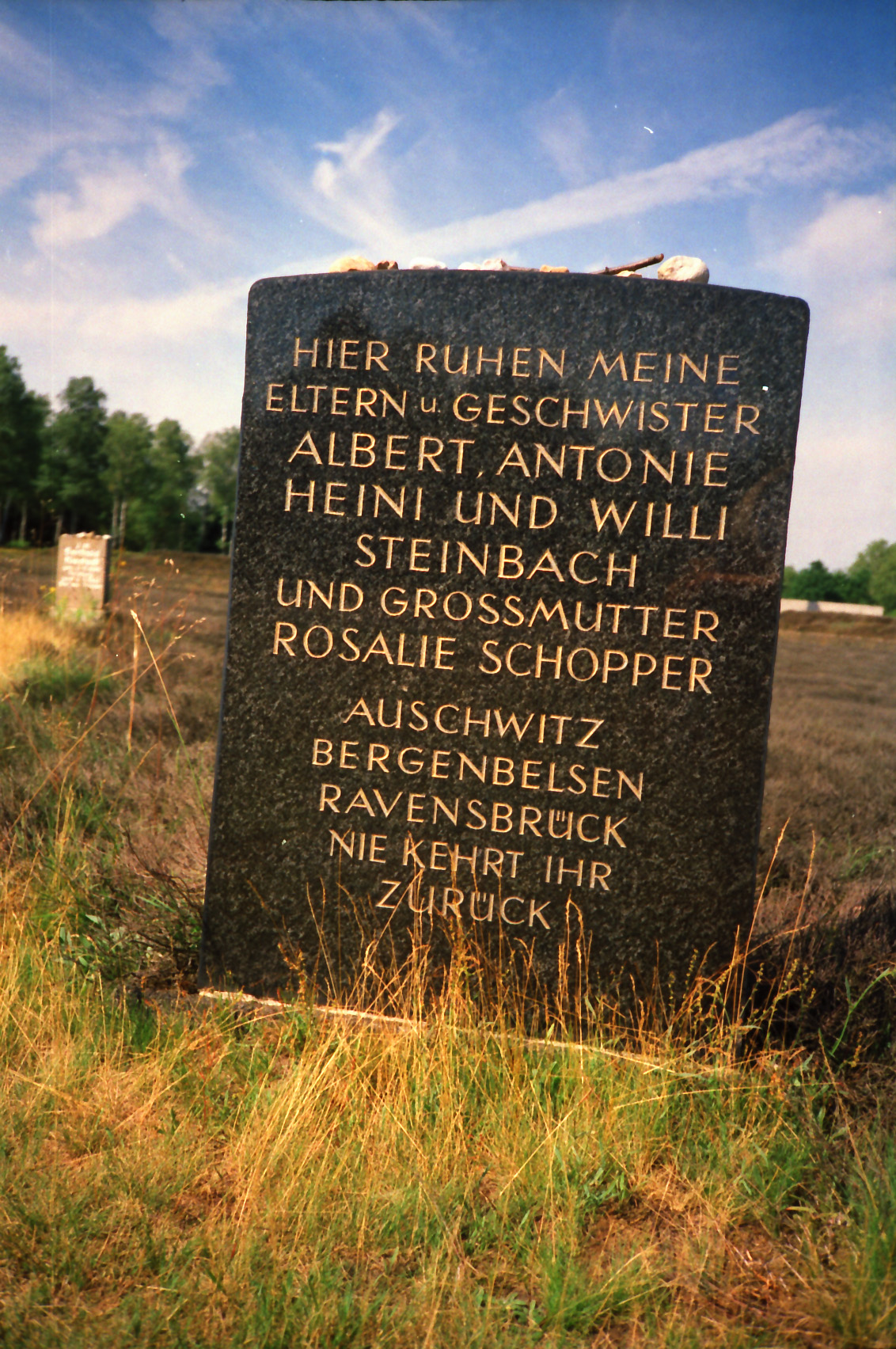Bergen-Belsen, located in the Belsen area of the town of Bergen in the Celle district in present-day Lower Saxony, Germany, was a special case in the history of Nazi concentration camps. Built in spring 1943 at the instigation of Reichsführer-SS Heinrich Himmler (1900–1945), in the southern half of a prisoner-of-war camp that was no longer fully occupied, it was initially assigned a specific function as an ‘exchange camp’ for Jewish hostages. From spring 1944, the camp was expanded to include further camp sections. The inmates of the Bergen-Belsen concentration camp included around 1,800 Sinti and Roma.
Camp for Jewish Hostages
Bergen-Belsen, also known as an ‘Aufenthaltslager’ [‘holding camp’], was initially used to detain certain groups of Jewish prisoners who were regarded as valuable hostages and were to be exchanged for Germans interned abroad. Bergen-Belsen was thus the only one of the main concentration camps that was initially set up solely for Jewish prisoners. Apart from a temporary construction detachment, only Jewish prisoners lived in Bergen-Belsen until spring 1944. Their living conditions were initially better than those in the other concentration camps. The ‘exchange camp’ was also a family camp from the outset, with a large number of children and young people. Despite its special function, the camp was subordinate to the SS (Schutzstaffel).
Formation of a Larger Camp Complex
In the spring of 1944, as the functions of the camp were expanded, the SS set up a succession of new subcamps, which no longer had anything to do with the exchange project. In this context, increasing numbers of non-Jewish prisoners, particularly political prisoners, were also sent to Bergen-Belsen. The result was an aggregation of several strictly separated subcamps with differently structured prisoner societies. The living conditions and thus the death rates in the various parts of the camp were also different.
The establishment of a men’s camp for sick and dying prisoners from different persecuted groups was followed by the construction of a women’s camp as a distribution centre for female prisoners for onward transport to forced labour, primarily in the armaments industry. From the end of 1944, both camp complexes developed into ‘reception’ camps and camps for dying prisoners for evacuation transports from concentration camps near the front, which brought a total of around 85,000 men, women and children to Bergen-Belsen by mid-April 1945. This resulted in catastrophic living conditions; in a very short time, the entire Bergen-Belsen camp complex developed into a death camp. In March 1945 alone, more than 18,000 prisoners died here, mainly from starvation and typhus. The hunger became so extreme that cannibalism even occurred.
A few days before the liberation, a camp section for around 15,000 male prisoners from the evacuated Mittelbau-Dora concentration camp was built on the site of the neighbouring Wehrmacht military training area, the so-called barracks camp.
When British soldiers liberated Bergen-Belsen on 15 April 1945, they found around 10,000 unburied bodies on the camp grounds. For many inmates, liberation came too late; in the first few days after liberation, hundreds of them died every day as the result of conditions in the camp. The total number of inmates in the Bergen-Belsen concentration camp is estimated at around 120,000, of whom at least 52,000 did not survive.
Shortly before the liberation, the SS managed to burn almost all of the camp’s files on site, including the individual inmate files and transport lists. For this reason, statistical questions about the history of the Bergen-Belsen concentration camp can often only be answered using parallel and substitute records, or only with estimates that are reasonably supported by other sources. The sources for the final phase of the camp’s history in particular are extremely fragmentary.
Sinti and Roma in Bergen-Belsen
Hardly any information on affiliation to one of the Romani-speaking groups can be derived from the sources. Among both the female and male Sinti and Roma who were imprisoned in Bergen-Belsen, a large number are not labelled as ‘Gypsies’ in the transport lists, but are grouped under abbreviations such as ‘ASR’ (‘Arbeitsscheu Reich’) or ‘AZR’ (‘Arbeitszwang Reich’) in the inmate group of ‘asocials’, and sometimes in individual cases assigned to the ‘criminals’ as ‘BV’ (‘Berufsverbrecher’) or ‘SV’ (‘Sicherungsverwahrte’).
By comparing various sources with the list of names of Bergen-Belsen concentration camp inmates compiled in recent years at the Bergen-Belsen Memorial, it is possible to identify the inmate categories assigned by the SS to those Sinti and Roma who can be identified by name. According to this, 93 of them were designated ‘asocial’ (49 of them children, i.e. prisoners up to the age of 14) on admission to Bergen-Belsen. There were four each in the ‘BV’ and ‘SV’ categories.
Women and Children
Although Sinti and Roma were occasionally included in the transports that were sent to the men’s camp from spring 1944, the first group transport did not arrive in Bergen-Belsen until 24 November 1944. This was a transport of 461 women from the Allach satellite camp in Dachau, which contained 125 Hungarian Roma, accompanied by their children, who were not recorded by name. These Roma had been arrested in nationwide raids in Hungary and taken from Budapest to Germany for forced labour at the beginning of November 1944.
Another transport of ‘Gypsy women’, which is documented by a surviving transport list, left the Altenburg satellite camp of Buchenwald concentration camp for Bergen-Belsen on 4 March 1945. Of the 150 women on this transport, 27 are listed as ‘Gypsies’.1Arolsen Archives, 1.1.3.1. Bergen-Belsen concentration camp, folder 2, transport list from Buchenwald/Altenburg concentration camp to Bergen-Belsen, 4 March 1945. Most of them were German Sinti. More than half of them were under the age of 25.
Finally, there was a transport from the Buchenwald satellite camp Taucha that departed for Bergen-Belsen on 1 March 1945, carrying 70 Sinti and Roma to Bergen-Belsen.2Ibid., transport list Buchenwald/Taucha concentration camp to Bergen-Belsen, 1 March 1945. Other transports which also brought Sinti and Roma with their children to Bergen-Belsen are documented as such, but there are no longer any transport lists for them, so it is not possible to provide precise information about how many Sinti and Roma were on these transports. This applies, for example, to two large transports of inmates from Ravensbrück, which arrived in Bergen-Belsen on 6 and 26 March 1945. A transport also arrived from Mauthausen on 19 March 1945, in which there is evidence of Sinti and Roma, including the Sintiza Antonie Steinbach (1899–1945) and her three children.3Archive of the Mauthausen Memorial, Mauthausen K 5/6, women’s registration book, transport from Mauthausen concentration camp to Bergen-Belsen, 19 March 1945. She and her two sons died before the liberation; only her nine-year-old daughter survived.
The available sources and data on Sinti and Roma women and children in the Bergen-Belsen concentration camp can be summarised as follows: most of them arrived in Bergen-Belsen starting in February and especially in March 1945. Overall, we can assume the presence of a minimum of around 1,000 Sinti and Roma women and children in Bergen-Belsen. The high number of children, including infants and toddlers, is remarkable. For example, the sources list 1945 as the year of birth nine times among the Sinti and Roma known by name. The available data leads to the conclusion that the percentage of children among the Sinti and Roma was higher than among any other inmate groups in Bergen-Belsen.
The majority of the women and children arrived at Bergen-Belsen when it had already become a ‘reception’ camp and a camp for dying prisoners. They were not housed together in one block, but were spread over several barracks with their children, together with inmates from other persecuted groups. Some of these barracks, which had been hastily erected since the end of 1944, lacked any interior furnishings, so they had to sleep on the concrete floor. The surviving sources give no indication that the girls and women were systematically deployed in internal camp labour detachments. Despite the catastrophic living conditions and rising mortality rates, the SS continued to hold daily roll calls in all parts of the camp in all weathers, during which the prisoners often had to stand for several hours and in which even small children had to take part.
German Sinti were clearly the largest subgroup among the female Sinti and Roma, followed by Hungarian Roma. A smaller number of Polish and Czech Roma are also mentioned in the sources, as well as stateless persons with German or Hungarian-sounding names. Only a few names of Western European Roma feature in the sources.
Male Prisoners
Most of the male Sinti and Roma, around 800, arrived in Bergen-Belsen much later than the women and children. In the last week before liberation the vast majority of them were sent to the ‘Kasernenlager’ [‘barracks camp’], which had been set up as an extension of the main camp in parts of a nearby Wehrmacht barracks on the Bergen-Hohne military training area. Almost all of them, including Otto Rosenberg (1927–2001), arrived from the Mittelbau-Dora camp complex on evacuation transports for which transport lists are no longer available. The inmates were also no longer registered when they arrived at the barracks camp.
In total, around 700 Sinti and Roma experienced liberation in the barracks camp and around 100 in the men’s camp. Those 100 men had arrived in Bergen-Belsen on 11 April 1945 on the only evacuation transport from Mittelbau-Dora that was not sent to the barracks camp. The SS attempted to recruit German Sinti in the barracks camp for deployment in the SS Special Unit Dirlewanger, to accompany them when they left Bergen-Belsen to fight at the front before the British troops arrived. It is not known how many of the Sinti accepted.
War’s End and Liberation
At the time of the liberation, the Sinti and Roma were the third largest group of prisoners in the Bergen-Belsen concentration camp after the political and Jewish prisoners. In the barracks camp, which was liberated on the same day as the main camp, there were lynchings of former ‘Kapos’ (functionary prisoners) by prisoners immediately after the liberation. Around 30 former prisoner functionaries fell victim to these on 15 April 1945 and around 130 to 140 the following day, including an unknown number of German Sinti who had performed this function in Mittelbau-Dora.
Because the camp registry was destroyed and the British liberators only documented the total number of former prisoners who died after liberation, but did not differentiate between persecuted groups and nationalities, it is not possible to provide exact information on the death rate among the Sinti and Roma in Bergen-Belsen. However, it is documented that the death rate among the Sinti and Roma women as well as the children who were liberated in the main camp was significantly higher than among the male Sinti and Roma. Around a quarter of all prisoners who were liberated on 15 April 1945 died in the first few weeks after liberation as a result of their internment. Assuming a comparable rate, the number of deaths among the Sinti and Roma can be estimated at around 300.
The survivors of the main camp were taken to the buildings of the neighbouring Bergen-Hohne barracks complex, which were now used mainly as an emergency hospital, and remained there until 19 May 1945. Only here could some of the women and children of the Sinti and Roma be reunited with male relatives from whom they had been separated during the deportations.
The survivors did not know what was in store for them when the SS personnel withdrew from Bergen-Belsen and the British army took over the camp. The majority of them, mainly German Sinti, fled the camp without being officially released in the first days and weeks after liberation. The most important motives for this escape were the uncertainty about what would happen to them in the liberated Bergen-Belsen camp and the search for family members who might have survived elsewhere, but also the fear of contracting typhus or other diseases at the last moment.
Most of the Eastern European Roma stayed on in the Bergen-Hohne barracks complex as displaced persons because they were dependent on the provision of transport for their return home. In August 1945, there were still Hungarian Roma in the camp.
Bergen-Belsen Trial
Just one day after the liberation, a British Army Film and Photographic Unit began documenting the situation. The images of thousands of emaciated corpses on the former camp grounds made Bergen-Belsen a worldwide symbol of the mass crimes of National Socialism and also served as evidence at the trial against the perpetrators, which began on 17 September 1945 in Lüneburg. The ‘Belsen Trial’ was also the first Auschwitz trial on German soil, as several of the defendants had also been deployed in the Auschwitz-Birkenau concentration and extermination camp. The crimes committed against Sinti and Roma were not explicitly mentioned.
Commemorative Rally 1979
As was typical in the postwar decades, the National Socialist persecution of the Sinti and Roma initially received no attention in the historical research or commemorative practices associated with Bergen-Belsen. This only began to change gradually with the emergence of Sinti and Roma political organisations.
An important turning point in this process was the first international commemoration and rally on the grounds of the Bergen-Belsen memorial site on 27 October 1979. At this event, organised by the Gesellschaft für bedrohte Völker [Society for Threatened Peoples], the Roma World Union and the Association of German Sinti, a total of around 2,000 participants, including 500 Sinti and Roma, remembered the persecution under National Socialism and at the same time called for an end to discrimination and restrictions on their civil rights. It was the first rally of this type and size by Sinti and Roma in the Federal Republic of Germany. The most prominent speaker was Simone Veil (1927–2017), the then President of the European Parliament, who had been liberated as a Jewish deportee in Bergen-Belsen at the age of 17. Bergen-Belsen was deliberately chosen as the venue for the memorial rally as it was the last stop on a long journey of persecution through Nazi concentration camps for many German Sinti and Roma.
Research and Memory
Historical research on the Sinti and Roma in the Bergen-Belsen concentration camp only began late and did not have much resonance. In Eberhard Kolb’s study published in 1962, which is still the standard work on the history of the Bergen-Belsen concentration camp, this group of inmates is not included. Even in more recent overviews, such as Alexandra-Eileen Wenck’s (born 1966) dissertation published in 2000, Sinti and Roma in Bergen-Belsen are mentioned only briefly in a note. It was the survivor and Austrian Romni Ceija Stojka (1933–2013) who, with her memoirs published in 1988 and her artistic work, made Bergen-Belsen known to a wider public as an important place of remembrance for Sinti and Roma. It was not until 1990 that Wolfgang Günther (biographical data unknown) published the first study on Sinti and Roma as inmates in Bergen-Belsen, in whose creation the Lower Saxony Association of German Sinti played a key role, and which remains the only monograph on the subject to this day. It aimed first to provide historiographical evidence that Sinti and Roma constituted an inmate group in Bergen-Belsen, and then to attempt to determine their approximate numbers.

Die Überlebende Ceija Stojka (1933–2013) in ihrer Wohnung in Wien, Österreich, 1999. Ceija Stojka, eine Lowara, wuchs in einer Familie auf, die vom Pferdehandel lebte. Sie wurde 1943 mit ihrer Mutter und ihren Geschwistern in das Konzentrations- und Vernichtungslager Auschwitz-Birkenau deportiert. Der Vater war schon 1941 nach Dachau verschleppt und in der Tötungsanstalt Hartheim ermordet worden.
Ceija Stojka überlebte Auschwitz-Birkenau sowie die Konzentrationslager Ravensbrück und Bergen-Belsen. Seit der Veröffentlichung ihres ersten autobiografischen Buches im Jahr 1988 zählte sie zu den wichtigsten Stimmen der Überlebenden. Fortan machte sie sich als Aktivistin, Künstlerin und Schriftstellerin einen Namen. 2009 ernannte das österreichische Bundesministerium für Unterricht, Kunst und Kultur Ceija Stojka zur Professorin.
Fotograf:in: Navigator Film
Navigator Film: Ceija Stojka, AT 1999
The source material for this first study also included audio interviews conducted by Wolfgang Günther with German Sinti in Lower Saxony who had been liberated in Bergen-Belsen. From September 1989 to February 1990, in cooperation with the Lower Saxony Association of German Sinti, 14 biographical interviews were conducted, some of them as group interviews, with a total of 18 interviewees. This interview project was continued from 1991 to 1994 under the direction of Heike Krokowski (biographical data unknown). As part of a cooperation project with the Bergen-Belsen Memorial, Hans-Jürgen Hermel (1935–2017) conducted nine video interviews with Sinti and Roma who had been imprisoned in the camp, beginning in 2001. If corresponding video interviews from the Fortunoff Video Archives at Yale University are also included, there are almost 40 interviews to date relating to the history of Sinti and Roma in the Bergen-Belsen concentration camp.
The Memorial Site
Although the Bergen-Belsen Memorial was the first institution of its kind to be established in the Federal Republic of Germany in 1952, it remained a memorial without staff for a long time. An initial exhibition in a ‘document house’ on the former camp grounds in 1966 did not include the Sinti and Roma victims. Following the recruitment of academic staff in 1987 and the start of collection and documentation activities, a new permanent exhibition was opened in 1990, which included only a brief sketch of the persecution of Sinti and Roma under National Socialism, reflecting the limited research that had been carried out by then.
Only the much more extensive permanent exhibition which opened in 2007 in a new documentation centre goes into more detail about the racially motivated genocide of this group of victims. Excerpts from video interviews with survivors are used at several points in the exhibition. In an in-depth section, the conditions and course of Nazi persecution are systematically presented and illustrated with biographies.
On the site of the former Bergen-Belsen concentration camp, Antonie Steinbach’s daughter had a memorial stone erected for her mother and her brothers Heini and Willi, who died in the camp. It also commemorates her father Albert Steinbach and her grandmother Rosalie Schopper, who were murdered in other camps.

Grabstein auf dem Gelände der Gedenkstätte Bergen-Belsen, Aufnahme circa 1997. In Erinnerung an ihre ermordete Familie ließ die einzige Überlebende der Familie, die bei der Befreiung des Konzentrationslagers Bergen-Belsen neun Jahre alt war, diesen Grabstein als Denkmal setzen.
Die Familie hatte seit 1936 im Zwangslager Berlin-Marzahn leben müssen. Die Tochter wurde mit der Mutter Antonie Steinbach (1899–1945) und ihren Brüdern Heini und Willi im April 1943 aus Berlin in das Konzentrations- und Vernichtungslager Auschwitz-Birkenau deportiert. Von dort wurden sie im August 1944 zunächst in das Konzentrationslager Ravensbrück und später nach Mauthausen überstellt. Kurz vor Kriegsende trafen sie mit einem Transport in dem völlig überfüllten Konzentrationslager Bergen-Belsen ein. Der Vater Albert Steinbach und die Großmutter Rosalie Schopper wurden in anderen Lagern ermordet. Der letzte Absatz der Inschrift auf dem Grabstein lautet: AUSCHWITZ / BERGEN-BELSEN / RAVENSBRÜCK / NIE KEHRT IHR / ZURÜCK.
Fotograf:in: unbekannt
Gedenkstätte Bergen-Belsen
On a large inscription wall is a text added by the Association of German Sinti after the 1979 memorial rally with the following wording: ‘In mourning and deep reverence // we Sinti (Gypsies) // remember the victims of our people. // Through their violent death // they are a reminder to the living // to resist injustice // to man by man.’




